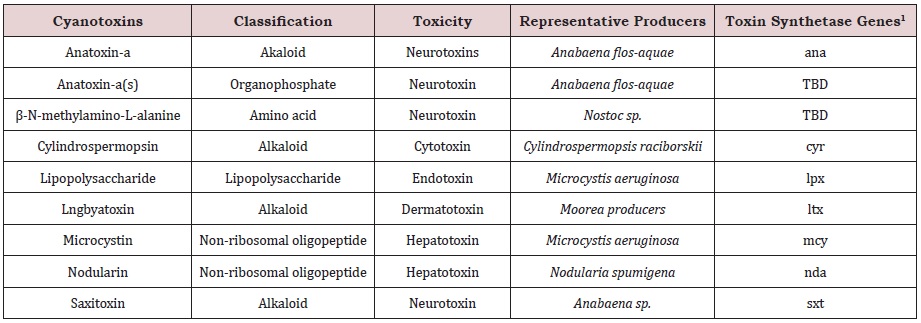Cyanotoxin Threats to Animals
SHORT COMMUNICATION
Cyanobacteria, also known as blue-green algae, are a group of photoautotrophic prokaryotes that grow in various habitats mainly freshwater all over the earth due to their strong adaptability to different environments. They can proliferate explosively and outgrow other freshwater microalgae once their optimal growth requirements are met such as enough nutrients and sunlight radiation, and warm weather. Their drastic proliferation always leads to a natural ecological disaster called cyanobacterial Harmful Algal Bloom (cyanoHAB), in which the culpable cyanobacteria are dominant in primary producer communities. CyanoHABs can exhaust key nutrients for other microalgae and thus inhibit their growth, and bacterial decomposition of excessive dead cyanobacterial cells can massively consume dissolved oxygen, creating deadly hypoxic (low oxygen) environment to aquatic organisms.
Similar to their eubacterial relatives, cyanobacteria are also able to produce secondary metabolites, and cyanotoxin is a notorious one among them. Hitherto, a variety of cyanotoxins have been discovered which possess no less than a hundred isoforms totally (Table 1). Most cyanotoxins are often synthesized by various intra- or inter-generic species, and different strains of some species can produce different toxins. Cyanotoxins can be classified into different chemical or functional groups according to their inherent properties or poisoning mechanisms (Table 1). Although some cyanotoxins like dermatotoxins may not result in serious toxicosis incidents, other toxins exhibit potent toxicity with dramatically low LD50 values, for example, intraperitoneally 25-150 μg microcystin per kg of body weight for mice. What’s even worse, toxins are usually accumulated beyond safety levels during cyanoHAB events, dramatically ramping up opportunities of poisoning.
While the real biological purpose of cyanotoxin production is still a mystery under investigation, these toxins are demonstrated to be extremely poisonous to animals especially mammals. For example, microcystin can inhibit protein phosphatases when entering hepatocytes and finally cause acute liver damage or failure; anatoxin-a around respiratory neurons binds to nicotinic acetylcholine receptor, but it cannot be degraded by acetylcholinesterase and thus keeps stimulating neurotransmission, eventually resulting in respiratory arrest. Animals often die in severe toxicoses, and in some cases, they rapidly lose vital signs without discernible symptoms or anomalous behaviors. Ever since the first scientific report of animal poisoning by cyanotoxin was published more than a century ago [1], substantial cyanotoxicosis incidents have been documented thus far. Puppies are likely the most vulnerable victims because they will swallow contaminated water when playing in ponds and lakes where toxin existence is not noticed. Livestock is susceptible to these toxins as well when unprocessed drinking water is directly used from contaminated water sources. Moreover, wild animals are affected such as deer and birds, whereas poisoning in reptiles, amphibians, fish, and invertebrates is rarely seen.
Scientists have developed cyanotoxin detection methods by ELISA, HPLC, and LCMS. Taking microcystin as an example, all these techniques can reach limits of detection of approximately 0.1 ppb (μg/L) which are much less than the suggested criteria for human health, for instance, 1 ppb by World Health Organization or 8 ppb by Environmental Protection Agency of the United States. Molecular detection targeting toxin synthetase genes (Table 1) has also been well established by conventional PCR, qPCR, etc. Estimation of gene abundance can help to evaluate toxin levels due to their good correlation discovered in previous studies, and furthermore, it can be regarded as an indicator for cyanotoxicosis risk assessment particularly in eutrophic (i.e., nutrient overloaded) waterbodies and hot seasons when cyanobacterial metabolism is active including toxin production. Please note that microscopic examination is not reliable because subspecific toxic strains may coexist with non-toxic counterparts while there is no morphological evidence to prove they are different.
CyanoHAB is occurring more frequently than ever before attributed to multiple factors, of which terrestrial nutrient overload is the foremost culprit, and this environmental issue is exacerbated under the pressure of global warming. Mass cyanoHABs take place in remarkable waterbodies annually, such as Lake Erie in the Great Lakes and Lake Okeechobee in Florida, and noticeable cyanoHABs are successively tracked in increasing numbers of waters including those where a cyanoHAB is never seen (refer to twitter account @ CyanoTracker). Therefore, public concern should be aroused before it’s too late to avoid large-scale animal poisoning or to support scientific investigation by reporting suspect cases and providing related on-spot materials.
REFERENCES
- Francis G (1878) Poisonous Australian lake. Nature 18: 11-12.
Article Type
Short Communication
Publication history
Received date: August 01, 2019
Published date: August 21, 2019
Address for correspondence
Jian Yuan, Department of Veterinary Diagnostic Production Animal Medicine, Iowa State University, USA
Copyright
©2019 Open Access Journal of Biomedical Science, All rights reserved. No part of this content may be reproduced or transmitted in any form or by any means as per the standard guidelines of fair use. Open Access Journal of Biomedical Science is licensed under a Creative Commons Attribution 4.0 International License
How to cite this article
Jian Yuan, Cyanotoxin Threats to Animals. 2019 - 1(1) OAJBS. ID.000102.



